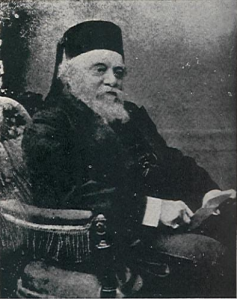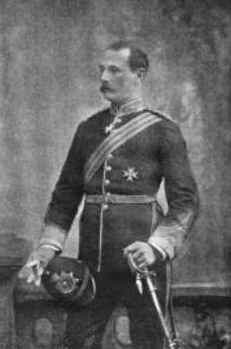Arms
 |
The Jejeebhoy Baronetcy (sometimes spelled Jeejeebhoy), of Bombay, is a title in the Baronetage of the United Kingdom. It was created 6 August 1857 for Sir Jamsetjee Jejeebhoy, [1] a prominent Parsee merchant and philanthropist who was the first Parsi and first Indian to be knighted (1842) and the first to be made a baronet (1857). When Sir Jamsetjee Jejeebhoy was made a baronet, it was realised that the Parsee custom was for a change of names for each generation. This conflicted with the British tradition of using consistent surname for a particular baronetcy. In 1915, the Imperial Legislative Council passed the Sir Jamsetjee Jejeebhoy Baronetcy Act, providing that all the male heirs should take these names and no other. Similar provision was made for subsequent Parsee baronets. All holders of the title relinquish their own names and assume that of the first Baronet.
Following Sir Jamsetjee's death in 1859, he was succeeded by his eldest son Cursetji as the second baronet. The second baronet had three sons; his eldest son Manekji succeeded him as the third baronet in 1877. The third baronet was appointed a Companion of the Star of India (CSI) and as a justice of the peace, served on the council of the Governor of Bombay. He had one son, Cursetji (1878–1893), who predeceased him at a young age, and was succeeded by his younger brother Cowasji, the fourth baronet, who came to be known as the leader of the Parsi community in Bombay. His only son, Rustamji, succeeded him as the fifth baronet in 1908, and was knighted as a KCSI and later served as vice-president of the Indian Legislative Assembly. The fifth baronet was succeeded by his only son Cowasji in 1931 as the sixth baronet. The sixth baronet only had three daughters, and upon his death in 1968, the main line of male descent from the first baronet failed. His second cousin Manekji succeeded him as the seventh baronet; Manekji was a great-grandson of the second baronet through his youngest son Jamsetji Cursetji (1860–1916) and through his son Rustamji (1884–1947). [2]
The heir apparent to the baronetcy is Jehangir Jejeebhoy (born 1986)
 |

Earl of Lonsdale is a title that has been created twice in British history, firstly in the Peerage of Great Britain in 1784, and then in the Peerage of the United Kingdom in 1807, both times for members of the Lowther family.

Viscount St Davids, of Lydstep Haven in the County of Pembroke, is a title in the Peerage of the United Kingdom. It was created in 1918 for John Philipps, 1st Baron St Davids. The Philipps family descends from Sir John Philipps, who represented Pembrokeshire in the House of Commons. In 1621 he was created a Baronet, of Picton Castle in the County of Pembroke, in the Baronetage of England. His grandson, the third Baronet, also sat as Member of Parliament for Pembrokeshire. He was succeeded by his son, the fourth Baronet. He represented Pembroke and Haverfordwest in Parliament. His son, the fifth Baronet, sat for Haverfordwest. He was succeeded by his younger brother, the sixth Baronet. He represented Carmarthen, Petersfield and Pembrokeshire in the House of Commons.

Sir Jamsetjee Jejeebhoy, 1st Baronet,, also spelt Jeejeebhoy or Jeejebhoy, was an Indian merchant and philanthropist. He made a huge fortune in cotton and the opium trade with China.

Sir Cowasji Jehangir, 2nd Baronet, was a prominent member of the Bombay Parsi community. He was the son of Sir Jehangir Cowasji Jehangir Readymoney, 1st Bt. (1853–1934) and grand-nephew of Sir Cowasji Jehangir Readymoney (1812–1878). He was educated at St John's College, Cambridge.

Sir Cowasji Jehangir Readymoney, CSI was a Parsi community leader, philanthropist and industrialist of Bombay, India.
The Wadia family is a Parsi family from Surat, India currently based in Mumbai, India. The family rose to wealth in the mid-1700s as shipbuilders serving the British East India Company as the latter established its sway over India. During the declining years of the British Raj, Neville Wadia, scion of the main branch of the family, married Dina Jinnah, only child of Muhammad Ali Jinnah, the founder of Pakistan. Despite being the only descendants of the founding father of Pakistan, the family chose to stick to their mills and factories in India rather than emigrate to the new country. They prospered abundantly under Nehru-Gandhi dispensation and today, they run the Wadia Group of companies, one of the larger industrial conglomerates in India.

Sir Dinshaw Maneckji Petit, 1st Baronet was an Indian entrepreneur and founder of the first textile mills in India, as well as a great philanthropist. He was part of the Petit family and became the first Petit baronet.
Sir Jamsetjee Jejeebhoy, 4th Baronet, was an Indian businessman.
Sir Jehangir Cowasji Jehangir Readymoney, 1st Baronet, was a prominent member of the Bombay Parsi community.
The Jehangir Baronetcy, of Bombay, is a title in the Baronetage of the United Kingdom. It was created on 16 July 1908 for Cowasjee Jehanghir, an influential member of the Parsee community in Bombay. He was the nephew and adopted son and heir of the Parsee community leader, philanthropist and industrialist Cowasji Jehangir Readymoney. By Special Act of the Legislative Council of India in 1911, it was decided that all future holders were to assume the name of the first Baronet on succeeding. The first Baronet was succeeded by his son, the second Baronet, who became a prominent politician.

Ardaseer Cursetjee Wadia FRS was an Indian Parsi shipbuilder and engineer belonging to the Wadia ship building family.

Sir Herbert Charles Perrott, 5th and 1st Baronet, was an English baronet who succeeded to a 1716 baronetcy in 1886 and was created a baronet in his own right on 21 June 1911 with precedence to his heirs male from the 1716 creation. Since there were no sons, the baronetcies became extinct with his death in 1922.

Kharshedji Rustomji Cama (1831–1909), often known as K. R. Cama, was an Indian Parsi scholar and reformer from Bombay.

Sir Cowasjee Jehangir High School is a co-educational private school in Tardeo, Mumbai, Maharashtra, India. It was established in 1859 by Sir Cowasji Jehangir Readymoney, a notable Parsi community leader, philanthropist and industrialist of the city.
Following the final collapse of the Mughal Empire in 1857 and the proclamation of the British Indian Empire, the British continued to maintain and recognise many of the old Mughal and Hindu styles and titles, introducing a compound honours system which awarded those titles along with British noble and aristocratic titles and knighthoods. Uniquely amongst the countries under British dominion, India was the sole country where British hereditary titles were conferred upon British subjects not of European ancestry. All British titles and honours became obsolete after the formation of the modern Republic of India in 1950, though they continue to be recognised by the British government. The Portuguese gave titles and created coats of arms for its Goan citizens from the early 1700s, both Hindu and Indian Christian. These titles however lost their recognition after the Portuguese Revolution and start of the First Portuguese Republic in 1910.
Major-General Sir Hiraji Jehangir Manekji Cursetji, KCIE, CSI, DSO was an Indian military surgeon and general in the British Indian Army during the Second World War.
The Parsi–Muslim riots occurred in 1851 in Bombay, and were reprised in 1874 in parts of Gujarat. These marked the beginning of a period of tension in the two communities. The first riot took place over the blurred depiction of the Islamic prophet, Muhammad, and his appearance in a public print by a Parsi newspaper, Chitra Gyan Darpan, in October 1851. A second riot place on May 1857,over a Parsi named Bejonji Sheriaiji Bharucha was accused of disrespecting a mosque by some Muslims. A third riot took place on 13 February 1874, over an article on the life of Muhammad in a book entitled Famous Prophets and Communities.
jejeebhoy arms crest.